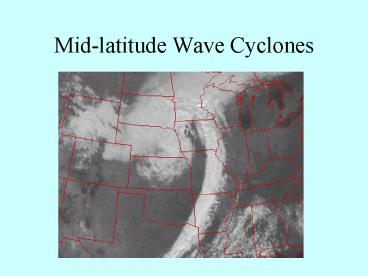Midlatitude Wave Cyclones - PowerPoint PPT Presentation
1 / 23
Title:
Midlatitude Wave Cyclones
Description:
Low pressure area with cyclonic (counter-clockwise) circulation. ... Strong vertical motion and unstable air forms cumuliform clouds ... – PowerPoint PPT presentation
Number of Views:71
Avg rating:3.0/5.0
Title: Midlatitude Wave Cyclones
1
Mid-latitude Wave Cyclones
2
Midlatitude Cyclones
- Extratropical cyclone or wave cyclone
- Low pressure area with cyclonic
(counter-clockwise) circulation. - Atmosphere collects water by evaporation and
returns it as precipitation - Major weather machine for mid-latitudes
- Counter-part in tropics is hurricane
3
Mid-latitude Cyclone Characteristics
- Motion these storms move across the midlatitudes
at about 30 m.p.h. from west to east as they
rotate around a low pressure center. - Size roughly 1,000 miles in diameter, the
largest of storms - Lifespan 3-6 days to develop, 3-6 to dissipate
- Pressure center roughly 990-1000 mb
4
The Midlatitude Cyclone
5
warm front
cold front
high pressure
warm sector
6
(No Transcript)
7
Typical Warm Front Structure
- In an advancing warm front, warm air rides up
over colder air at the surface slope is not
usually very steep - Lifting of the warm air produces clouds and
precipitation well in advance of boundary - At different points along the warm/cold air
interface, the precipitation will experience
different temperature histories as it falls to
the ground
8
Typical Cold Front Structure
- Cold air replaces warm leading edge is steep in
fast-moving front shown below due to friction at
the ground - Strong vertical motion and unstable air forms
cumuliform clouds - Upper level winds blow ice crystals downwind
creating cirrus and cirrostratus. Note change in
wind and temperature as front passes. - Slower moving fronts have less steep boundaries
and less vertically developed clouds may form if
warm air is stable
9
The Partially Occluded Stage begins when the cold
front starts to overrun the warm front
Middle age
10
The Occluded Stage is characterized by more warm
air being pushed aloft and the size of the warm
air wedge at the surface decreases
significantly
Over the Hill
11
Storm Tracks North America
Storms (Storm Tracks) generally travel from West
to East in North America all year They shift
North in summer South in Winter
Actual Storm Tracks (1991)
Average Storm Tracks Moving West To East
12
page 259
13
1993 Storm of the Century
- The "Storm of the Century" was not the
worst storm ever, but it affected a large area.
On the Saffir-Simpson hurricane scale it would
have been a category 3. The storm affected 26
states and 50 of the US population.
This 'Superstorm' was one of the largest storms
to hit the US. At one point, the storm covered
1/3 of the US. Damage estimates were from 3 to
6 billion. - Florida was strongly affected. The western
coast received hurricane force winds with
estimates up to 120 mph with a ten foot storm
surge while Tallahasee received 3 inches of
snow. 27 tornadoes also touched down.
14
1993 Storm of the Century
- Produced 27 tornadoes in Florida
- Estimated volume of water was about 20 days of
MS River flow at New Orleans - 270 deaths
- 5 billion US in damage
- Closed every major airport along the east coast
15
Storm of the Century 93
16
(No Transcript)
17
What is a blizzard?
- Severe winter storms that combine blowing snow
and wind resulting in very low visibilities - Typically heavy snows and severe cold occur,
these are not required - Officially, a blizzard is
- Large amounts of falling or blowing snow with
winds greater than 35 mph and visibilities less
than .25 miles for greater than 3 hours
18
(No Transcript)
19
(No Transcript)
20
(No Transcript)
21
(No Transcript)
22
?
Discussion ?
23
Storm of the Century Video Worksheet
- Watch the video and complete the worksheet
- Discuss any questions
- Turn in worksheet with your name
- Will be able to use on next test.































